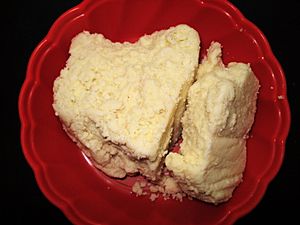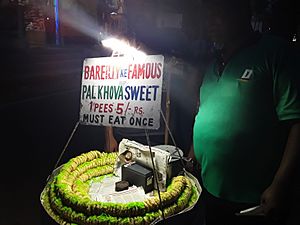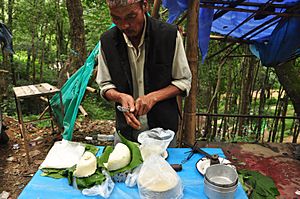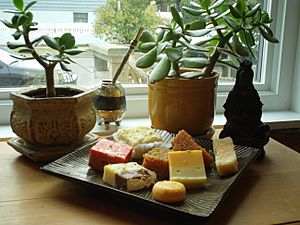Khoa facts for kids

Kurauni
|
|
| Alternative names | kurauni, khoya, koa, kova, maua, khowa, khava, khuaa, mawa |
|---|---|
| Place of origin | Indian Subcontinent |
| Region or state | Indian Subcontinent |
| Associated national cuisine | India, Bangladesh, Pakistan, Nepal |
| Main ingredients | Milk |
| Similar dishes | Kheer |
Khoa (also called khoya, khowa, or mawa) is a popular dairy food. It is widely used in the cooking styles of the Indian subcontinent. This includes countries like India, Nepal, Bangladesh, and Pakistan.
Khoa is made from milk that has been dried or thickened. This happens by heating the milk in a large, open pan. It's different from fresh cheeses because it has less water. Khoa is made from whole milk, not from the liquid part of milk called whey.
How Khoa is Made
To make khoa, milk is cooked down until it's only about one-fifth of its original amount. This process removes most of the water. Khoa is a key ingredient for many different Indian sweets. India makes about 600,000 metric tons of khoa every year!
Khoa can be made from both cow milk and water buffalo milk. To make it, full-fat milk is slowly cooked in a wide, shallow iron pan. This happens over a medium fire for several hours. As the water slowly evaporates, only the milk solids are left behind.
There is also a quicker way to make khoa. You can add full-fat milk powder to skimmed milk. Then, you mix and heat it until it becomes thick. However, this quick method might not taste exactly like traditional khoa.
Khoa is usually white or a light yellow color. Sometimes, if it's made in winter and saved for summer, it might get a green tint. This green color comes from a harmless mold on the surface. This type is called hariyali (meaning green khoa). It is used in recipes where the khoa will be cooked thoroughly, like in gulab jamun. Today, with refrigerators, hariyali is not made as often.
Different Kinds of Khoa

Khoa comes in different types. These types depend on how much moisture (water) is left in them. Each type of khoa is used for making different kinds of sweets.
- Batti: This type means "rock." It is the hardest kind of khoa, with about 20% moisture. You can even grate it like cheese. It can be stored for up to a year. Over time, it gets a special smell and a moldy outside.
- Chikna: This name means "slippery" or "squishy." It has more moisture, about 50%.
- Daanedaar: This is a grainy type of khoa. During cooking, an acid is added to the milk to make it curdle. It has a medium amount of moisture. It is used to make sweets like kalakand and gourd barfi.
- Pindi: This is a dry type of khoa. It is often used for making sweets like barfi and peda.
- Dhap: This version is less dried than others. It is used to make popular sweets such as gulab jamun and pantua.
What Khoa is Used For
Khoa is a key ingredient in many delicious sweets:
- Pedha: This sweet is made by sweetening khoa and shaping it into balls or thick disks. Flavors like saffron or cardamom are often added.
- Gulab jamun: These are round ball-shaped sweets made from khoa. They are deep-fried and then soaked in a sweet syrup flavored with rose water or honey. Gulab jamun is a very popular Indian sweet.
- Barfi: Barfi is also flavored, but khoa is not the only ingredient. Often, other ingredients like thickened fruit pulp or coconut shavings are added to khoa. This mixture is cooked slowly until it becomes thick like fudge. Then, it's flattened and cut into different shapes.
- Gujia: This is a sweet fried dumpling. It is filled with khoa and nuts. Gujia is a very popular sweet, especially during the Holi festival.
- Halwa: Halwa is a fudge-like sweet. Khoa can be added to wheat starch or cornstarch and sugar syrup. This gives it a creamy taste and texture and helps to thicken it. However, many halwa recipes do not use khoa. They rely on starch, sugar, nuts, and spices like cardamom or saffron.
- Main Course Dishes: Khoa is also used in some main dishes in North India. Examples include khoya paneer, Makhmali Kofte, and Khoya Matar.
- Naan Roti: Some Muslim bakers in Bangalore specialize in Naan roti stuffed with khoa.
- Ice Cream: In India, Cream Bell Ice Creams sells a brand called Royal Rajwadi. It has thick layers of cold-pressed mawa covered in a thin layer of Indian Kulfi ice cream.
See also
 In Spanish: Khoya para niños
In Spanish: Khoya para niños



